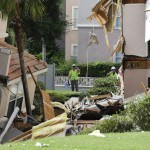

CoreLogic, a residential property information, analytics and services provider, on Wednesday released its annual Natural Hazard Risk Summary and Analysis detailing the most significant natural disasters that struck the United States in 2013.
The report, compiled by CoreLogic hazard scientists, provides an analysis of the property, geographic and financial impacts of hurricane, flood, tornado, wildfire and sinkhole events over the course of the year, as well as a summary of potential risk from natural hazards in 2014.
“Many predicted that 2013 would be a record year of catastrophic destruction,” said Dr. Thomas Jeffery, senior principal scientist for CoreLogic, “but the number of natural disasters that typically cause widespread destruction—mainly hurricanes, wildfires and tornadoes—were far less than anticipated in comparison to last year’s record-setting hazard seasons.”

“Interestingly, one natural hazard that tends to receive very little attention took center stage in 2013 as three separate sinkhole catastrophes took place in Florida. Though massive damage and loss of life from sinkholes is uncommon, this year’s events were large enough disasters to draw significant media coverage, raising public awareness of the true risk associated with this often-overlooked hazard,” he added.
Hurricane
2013 saw only 13 named storms, and just two reached hurricane classification. Hurricane totals were lower than pre-season predictions and disproportionately lower than previous hurricane seasons dating back to 2003. None of the storms had a direct impact on the U.S.
The first official hurricane of the year, Hurricane Humberto, formed on Sept. 11—just three hours short of setting the record for the latest formation of the season’s first hurricane.
Flood
Flooding in the U.S. was moderate compared with recent years, partly due to the low number of Atlantic storms and the related coastal flooding. National flood losses for 2013 are expected to total approximately $2 billion.
The most significant flooding event of the year was a September storm in Boulder, Colo., which caused the damage or destruction of more than 19,000 homes and resulted in record-setting levels of precipitation and flooding affecting 17 Colorado counties.
CoreLogic developed the first National Catchment Slope Map in 2013, illustrating the structural hydrology of the U.S. landscape to identify the metropolitan areas at risk for catastrophic flood events.
Tornado
Total tornado activity in 2013 was at a historic low, with 229 fewer tornadoes than any year in the past decade as of October 25.
On May 20 an EF5 tornado swept a 17-mile path through Moore, Okla., killing 23 people, injuring 377 others and causing an estimated $2 billion in damage.
The widest tornado ever recorded—2.6 miles at its widest point—struck El Reno, Okla., in early June, resulting in eight fatalities and nearly $40 million in damage.
Wildfire
The number of wildfires and total acreage burned in 2013 were lower than both the 2012 season and the 10-year average. Excluding California, Colorado, Idaho and Washington, which perpetuated their 10-year average in terms of acreage affected, the Western states saw dramatically lower wildfire activity than in recent years.
Several individual fires caused massive destruction, including Arizona’s Yarnell Hill Fire, which destroyed 8,400 acres and 129 homes, and Colorado’s Black Forest Fire, which burned 14,000 acres, destroyed or damaged more than 500 homes, and resulted in a total property loss expected to exceed $300 million.
The Rim Fire was the third largest fire in California state history, destroying only 11 homes but burning more than 257,000 acres, including much of the Stanislaus National Forest and Yosemite National Park.
Persisting drought conditions in California, Nevada, Arizona, New Mexico, Texas, Utah and Colorado indicate the potential for increased wildfire risk in 2014.
Sinkhole
Three unusually severe examples of sinkhole activity in Florida captured public attention in 2013: A sinkhole in Seffner caused a tragic death in March when it formed underneath a man’s home; a tourist villa was heavily damaged when a 100-foot sinkhole formed near Clermont; and a 90-foot wide, 50-foot deep sinkhole resulted in the collapse of two homes in Dunedin.
The CoreLogic sinkhole database currently recognizes 23,000 identified sinkholes, suggesting that sinkhole activity and subsequent property damage will continue to be a substantial risk across the nation—and for Florida residents in particular.
“Though there have been fewer billion-dollar catastrophes over the course of 2013, history has demonstrated time and time again that a temporary reprieve from natural disasters cannot and should not be expected to continue into the future,” said Jeffery. “Going into 2014, it’s important to remember that hazard-driven property damage and loss can and does occur each year, and with the cyclical nature of some of these events, this year should be considered fair warning that next year will likely see a return to the higher average numbers of damaging natural disasters.”